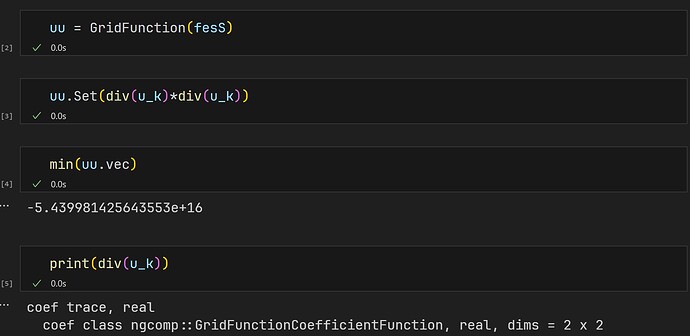from ngsolve import *
from netgen.geom2d import SplineGeometry
import numpy as np
## Solve the linear elasticity problem of variable density
# \int_D \phi^p * Ae(u):e(v) *dx = \int_D f*v *dx + \int_{\Gamma_N} g*v *ds
## Setting mesh and Finite elements space
#LS=矩形半长边,SS=矩形半短边,FH=短边上分段的点
LS = 1.5
FH = 0.5
SS = 1.0
delta = 0.05
SIZE = 0.05 #mesh size
# y
# Set points of boundary # |
POINTS = [(LS, SS), # 2---------|---------1
(-LS,SS), # | | |
(-LS, FH), # 3 | 8
(-LS, -FH), #-|----------|----------|---->x
(-LS, -SS), # 4 | 7
(LS, -SS), # | | |
(LS, -delta), # 5---------|----------6
(LS, delta)]
GEO = SplineGeometry()
# Set name of points
P1,P2,P3,P4,P5,P6,P7,P8 = [GEO.AppendPoint(*P) for P in POINTS]
# Set name of boundaries
BNDS = [[["line",P1,P2],"BND1"],
[["line",P2,P3],"BND2"],
[["line",P3,P4],"BND3"],
[["line",P4,P5],"BND4"],
[["line",P5,P6],"BND5"],
[["line",P6,P7],"BND6"],
[["line",P7,P8],"BND7"], # 牵引力作用于一小段
[["line",P8,P1],"BND8"],]
# Add boundary to GEO
[GEO.Append(c,bc=bc) for c,bc in BNDS]
# Generate mesh
mesh = Mesh(GEO.GenerateMesh(maxh=SIZE))
# Set boundary condition
DB_MARK= "BND2|BND4"
NB_MARK= ""
## Finite elements space of liner elasticity problem
fesV = VectorH1(mesh, order = 3, dirichlet = DB_MARK)
## Finite elements space of Allen-Cahn equation
fesS = H1(mesh, order = 3)
## Initial liner elasticity model parameter
nu = 0.3
E = 210
lamda = nu / ((1+nu)*(1-2*nu))*E #
mu = 1 / (2*(1+nu))*E #
p = 3 #
phi0 = 0.0001 #
# 设置CF类型的外力函数g
g = CF((0,-10)) #尽管设置在全区域,但只采用边界积分
# volume forve
force = CoefficientFunction( (0,0) )
## define absolution function
Absx = IfPos(x,x,-x)
Absy = IfPos(y,y,-y)
## Initial phi
phi = IfPos(0.08-(Absx-0.75)**2-(Absy-0.5)**2, \
IfPos(0.08-(Absx-0.75)**2-(Absy-0.5)**2 - phi0,\
0.08-(Absx-0.75)**2-(Absy-0.5)**2,phi0), 1)
phi_k = GridFunction(fesS)
phi_k.Set(phi)
## Strain and stress tensor
def strain(u):
return Sym(Grad(u))
# e(u) = 1/2(Grad(u)+Grad(u)^T)
def stress(u):
return 2*mu*strain(u) + lamda*Trace(strain(u))*Id(u.dim)
# Aε = λ tr(ε)I + 2με , Ae(u) = 2μe(u) + λ div(u)I
## Solve liner elasticity problem with phase field \phi
print("Being computing displacement field...")
#define trial- and test- function
u = fesV.TrialFunction() #trial function
v = fesV.TestFunction() #test function
# the right hand side
print(" Computing linear form...")
f = LinearForm(force*v*dx + g*v*ds('BND7')).Assemble()
#\int_D f\cdot v dx + \int_Gamma_N g\cdot v ds
# the stiffness matrix
print(" Computing stiff matrix...")
a = BilinearForm(fesV)
a += phi**p*InnerProduct(stress(u), strain(v)) * dx
a.Assemble()
# int_D \rho^p Ae(u):e(v) dx
gfu = GridFunction(fesV) # displacement
gfu.vec.data = a.mat.Inverse(fesV.FreeDofs(),inverse="sparsecholesky")* f.vec
uu = GridFunction(fesS)
uu.Set(div(gfu)*div(gfu))
print(f"The minimum value of A on the grid is {min(uu.vec)}.")
